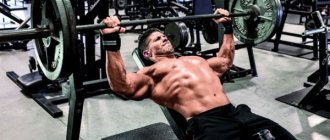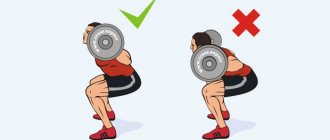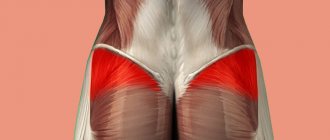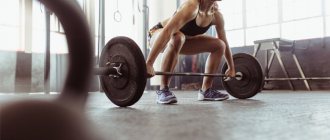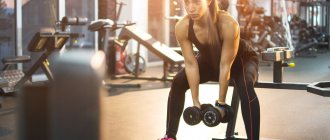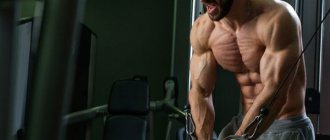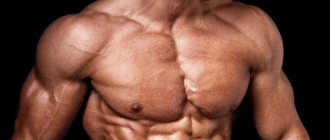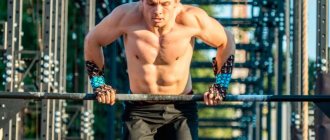June 12, 2016 Admin Home page » Tips and recommendations
Learn how to add volume to your lower bust area and make your breasts appear more defined and defined. Read 8 important rules and apply them in training!
In most cases, during training, the middle and upper sections of the pectoral muscles are worked out, while the lower one is left without attention and if you train, then with the thought - a couple of times a year is enough, the chest already works hard.
Although the lower part of the pectoral muscles is the first to stand out both on the beach and in a T-shirt, it is the most massive part of the pecs, which gives an attractive view of the torso from the front and emphasizes the strength and health of its owner. Read on to find out how to close the gap in this problem area.
Train the lower area first
Usually, on the day of training the pectoral muscles, visitors, after warming up and stretching, go to the bench press on a horizontal bench, then there is a bench press on an inclined bench with your head up and rarely a third exercise upside down, but dumbbells can also be used. Working in this sequence, devoting only the third exercise to the lower chest, you will spend a lot of energy and the working weight will be greatly reduced.
In the same way, having crossed the threshold of the gym and keeping in mind the goal - how to pump up the lower part of the chest, you should immediately go to the barbell press upside down, making it the first exercise.
This is the only way you can work out your muscles well when you are full of energy and strength, engaging the most dormant muscle areas in the work, do not be afraid to take the weight for 6-8 repetitions, but use the help of a spotter, due to the inconvenience of performing the exercise, it may fall on your neck, oh the consequences of thinking do not need to be said.
Proper nutrition for weight gain
When planning your diet, you need to follow three basic rules:
- Don't eat extra calories. Eating extra calories does not guarantee building bigger muscles. It is better to calculate your own metabolic rate and consume as many calories as needed. On a “dried” body, the shapes become more prominent. Pure carbohydrates such as pasta, white bread, cakes, flour, fatty and fried foods should be avoided.
- It is necessary to increase your intake of protein, which is found in chicken, fish, beef, pork, eggs, milk, nuts, beans, cabbage and other foods.
- In addition to a proper diet, many athletes use a variety of supplements such as creatine or amino acids in powder form. The supplement should be diluted with water and drunk 3-4 times a day.
Such supplements are safe, they have passed all tests and confirmed the quality guarantee, since their composition is identical to protein of natural origin.
2. More exercises for the lower chest
This is the first rule that should immediately come to mind when it comes to pumping up the lower chest.
To do this, you need to pay attention to different exercises from different angles in order to include more muscles in the work and work them from all sides. To do this, use a different angle of negative inclination, set each new exercise at different angles, preventing their repetition.
An example of basic exercises is as follows:
- Head down incline press
- Dumbbell head down press
- Smith machine press with negative incline
- Dips for chest
- Angled push-ups (torso at a 30-degree angle pointing upward)
Basic mistakes
Inexperienced athletes often make mistakes. In order for the training to bring results, the exercise technique must be strictly observed. You can't take too much weight, you need to start small. Selecting individual exercises with optimal weight can only be done by trial.
In an upright position, many people feel bad - their eyes may darken, their ears may ring, and their blood pressure will increase. You can avoid these unpleasant conditions by reducing the angle of the bench to 30 degrees.
Incorporate new exercises
Of course, the arsenal of exercises for targeted pumping of the lower chest is not large, but this should not confuse you with the solution to the question of how to pump up the lower chest. If you have been working in a gym, it’s time to change it to dumbbells and barbells, change the sports equipment every time, change the angles of the gymnastic bench and the back of the exercise equipment, introduce innovations and diversity.
All this will allow the muscles not to get used to the load and cause them to always experience stress, which means they grow.
Basic principles of training
To strengthen your breasts and give them a sculpted shape, you need to follow these rules:
- It is better to do several exercises, this will evenly distribute the load on all muscle areas. With one specific exercise, the result will not be effective.
- The workout should begin with an exercise for the lower pectoral muscles. If you don’t start doing it at the beginning, then by the middle of the workout you will no longer have the strength to do it.
- If the goal is to give the breasts relief shapes, then this part of the body needs to be given more attention.
- Sometimes you can take a short break and relax. But after a few days you should definitely start training, since the key to an ideal figure is stable loads and exercises.
After rest, the body will recover and exercise will be even easier. It is best to develop a specific program or scheme in which training for different muscle groups will be scheduled by day.
Push-ups on the uneven bars with emphasis on the chest
Regular parallel bars work great on the chest and triceps, the main thing is to know the correct technique, then you can direct a more targeted load specifically to the lower area, namely:
— You need to do push-ups with your body tilted forward, at about an angle of 30-45 degrees. For the first time, you can ask your partner to slightly raise your legs up, which will make it easier to keep your body at an angle.
— During the movement, the elbows should diverge to the sides, and not press against the body, the angle between the body and the elbows is about 45 degrees, this will allow the load to be taken from the triceps and sent to the chest.
— When doing push-ups, do not straighten your elbows completely at the top point, this will allow you to maintain the load in the chest muscles and quickly achieve muscle failure.
The structure of the pectoral muscles
The following muscles are located on the human chest:
- Pectoralis major muscle. She is the largest on the chest. It is fan-shaped and flat. Responsible for lowering the arm and turning it towards the body. It's the easiest to pump up.
- Pectoralis minor muscle . This triangular muscle is located under the pectoralis major and is attached in three places to the ribs and in one to the shoulder blade. Responsible for moving the scapula forward, as well as raising the ribs.
- Subclavius muscle . It is located between the upper rib and the collarbone and is responsible for its movement down and inward.
- Serratus anterior muscle. It is flat and is located on the sides of the remaining pectoral muscles, overlapping them. Pulls the scapula forward and outward, and is also responsible for its rotation and elevation of the arm.
- Subcostal muscles . From their name it is easy to understand that they are located inside the chest, under the ribs, and are responsible for breathing, raising and lowering it.
- Aperture . It's not really a muscle; it's partly made up of connective tissue. It separates the abdominal cavity from the chest and is involved in the breathing process.
Train effectively
Don’t forget that there are many methods for performing approaches, don’t forget about them, but actively implement them:
Negatives - when you are no longer able to lift the barbell or press the levers in the machine, ask your partner to help you push the weight up almost completely, while lowering the weight yourself. Perform it in the last 1-2 sets of the exercise.
The Rest-Pause method breaks the usual approach into smaller ones. For example, you have 8 repetitions in your plan, you did 3 repetitions, returned the bar to the racks and rested for 20 seconds, then again 3 repetitions and rested for 20 seconds, and so on until you pressed at least 2 times.
Drop sets are a great way to increase muscle volume in the short term, by completing the required number of repetitions, quickly lower the weight by 25% and again perform the same number of repetitions as in the first case, and so on, reduce the weight, without resting you get to the empty bar, your chest will fill up and at least for a while you will feel like Hercules.
Training to failure is performing an exercise when, on the last repetition, you feel that the apparatus will simply fall out of your hands due to complete physical and emotional fatigue.
Forced repetitions - involve the help of a partner who slightly helps lift the weight, while the weight is lowered independently without assistance.
The main thing to know is that these methods cannot be used constantly, only from time to time, otherwise the muscles will go into a plateau (stagnation), which means a complete stop in muscle growth.
Tips and tricks
The desired muscle group should be developed at the beginning of the session. Exercises should be varied; you cannot focus on one thing. Over time, you should change the angle of the bench, add weight or increase the number of repetitions. Periodically you need to include new loads and strength exercises in your training. An important aspect is a balanced diet and healthy sleep. After intense training, you can take a few days off, then you need to train again. The body relaxes and tolerates new loads better.
Surgical methods to combat breast drooping
The current level of development of plastic surgery makes it possible to quickly, effectively and at the same time safely eliminate external defects caused by sagging mammary glands. The GALAXY Beauty Institute uses methods that have proven their effectiveness, after which there are no visible scars, cicatrices or other blemishes on the skin.
An operation aimed at lifting the breasts is called mastopexy. It involves excision of excess skin and, if necessary, correction of the size and shape of the mammary gland. Depending on the method of access, the age and personal wishes of the patient, the characteristics and degree of ptosis, three options for mastopexy are distinguished.
- Periareolar. The incision is made around the areola, which allows you to remove excess skin with minimal intervention and at the same time correct the position of the nipple. The technique is used for 1st degree breast prolapse.
- Circumvertical. The incision is made along the lower edge of the areola and from top to bottom from the inframammary fold, which gives the surgeon a greater view. During such an operation, the doctor can remove excess tissue, change the shape and size of the breast, and adjust the location of the nipple. Circumvertical mastopexy is indicated for grade 2 and 3 ptosis.
- Anchor or T-shaped. In this case, the incision is made vertically from the areola to the inframammary fold, as well as horizontally along the fold. This access gives the surgeon almost unlimited possibilities. During the procedure, you can not only eliminate excess skin, but also reduce or increase the volume of the mammary gland, insert implants, radically change the contours of the bust, areola, move the nipple, eliminate asymmetry and completely recreate the shape inherent in a young breast.
Each of the surgical options has its own indications, advantages and disadvantages, which you can learn more about during a face-to-face consultation with plastic surgeons at the GAGALKTIKA Beauty Institute.
Simultaneously with the lift, it is rational to carry out auxiliary procedures for breast modeling. These include:
- reduction mammoplasty, which involves reducing the size of the mammary glands;
- augmentation mammoplasty, which involves the installation of implants;
- autolipotransplantation or lipofilling, which is a small volume of the breast and correction of its shape by transplanting the patient’s own fat cells.
The choice of a specific mastopexy option depends on the initial condition of the mammary glands, age, health characteristics and personal wishes of the woman. If there are indications and there are no contraindications, the operation can be performed at any age after reaching adulthood.
Indications for the procedure
The reasons to contact the GALAXY Beauty Institute for a breast lift are any changes in the shape and position of the mammary glands, nipple-areolar complex (NAC), combined with the patient’s desire to change their shape and/or size. After examination and preliminary examination, the surgeon will tell you whether the operation is possible.
Benefits of Mastopexy
The main advantages of the procedure are:
- the possibility of dramatic changes and rejuvenation of the breast;
- minimal preparation;
- low risk of serious complications;
- long-term results if you follow surgeons’ recommendations;
- minimal tissue damage;
- absence of obvious signs of interference after recovery;
- short rehabilitation period.
Therapeutic complex - rules of implementation
With correct and regular gymnastics, you can achieve the following results.
- Increase your overall level of physical activity.
- Relax your muscles.
- Release inflamed nerve roots from tightness.
- Eliminate physical inactivity.
- Eliminate congestion in blood vessels.
- Strengthen the muscle frame.
- Improve blood flow.
- Normalize metabolic processes.
Important! If you have diseases in the thoracic region, you can start doing exercises only after consultation with your doctor and approval of the complex by a physical therapy instructor.
Consult a doctor before starting classes
In order for the exercises to bring the desired effect, you must adhere to the following rules when performing them.
- Do not make sudden movements during gymnastics to avoid worsening symptoms.
- Increase the load gradually.
- In case of exacerbations of pathologies, perform only selective simple exercises.
- If movements cause or aggravate pain, temporarily, until the condition improves, exclude them from the complex.
Dosage of physical activity
There are a number of absolute contraindications for performing gymnastics not only that regulate the activity of the muscles of the thoracic region, but also any complex in general.
We pump up the lower chest in the gym
We have the following exercises at our disposal:
- Bent-over dumbbell press (legs above head);
- Bent-over barbell press (legs above head);
- bringing your arms together in a crossover (arms below your chest);
- bars again.
Bent over dumbbell and barbell press
Let's be honest, the dumbbell press is performed exactly the same as the barbell press, so we'll look at both exercises here. We will need a wall bars and an inclined bench that can be mounted on this wall at any angle. We hang the bench 30 degrees down.
- We take dumbbells (we start with a warm-up) weighing 5 kg, leave them on the sides of the edge of the bottom of the bench.
- We lie down on the bench with our feet up (we attach them to special bolsters that should be on the bench). Now you are hanging upside down. Take dumbbells and place them in front of you so that there is a right angle between your hands and the floor.
- Unfold the dumbbells as if you were holding a barbell. Lower the weight onto your chest, spreading your elbows to the sides.
- We lift as we exhale. Don't hold your breath!
Then we take working weights and work out. If you find it difficult to lift the weight yourself, ask a trainer or partner. Usually you pick up one dumbbell yourself, and the second one is handed to you by your partner.
If you are working out with a barbell, your partner must remove and deliver the barbell. He also insures you during the exercise.
The lower your head, the more load the desired part of the chest receives. You can lower the bench either 45 degrees or 60.
Bringing hands together in crossover
We will deal with the upper blocks. We hang handles on the cables that are easy to grip with one hand. We warm up with 2–4 kg to understand the essence of the exercise and the technique of movements:
- We spread our arms to the sides and grab the handles with a direct grip, palms down. We slouch a little to tighten our pectoral muscles. At this moment, you look like an eagle during the landing, when it slows down with its wings (usually, such a comparison immediately clarifies all the points).
- We move one leg back for stability. We tilt the body forward and slightly down. The lower back is arched, the pelvis is laid back.
- We begin to bring our hands together, the crossing point will be at the level of the groin or lower. This position ensures pumping of the lower pectoral muscles.
- We do 10 repetitions. Then we hang the working weight and perform 3 sets of 10–12 repetitions.
Bars in the gym
If you do 15-20 push-ups, there is no point in working without weight:
- Ask the trainer on duty for a special weight belt.
- Do 15 push-ups as a warm-up.
- Do 5-8 push-ups without weight (if you have enough strength and can do many push-ups without weight, 10-15 times will do for a warm-up).
- We hang the pancake on our belt. We carry out the working approach using the technique described above.
Let's go as low as possible. For greater effectiveness, it is recommended to stretch on the parallel bars before doing push-ups. To do this, grab the handles in the same way as when doing the exercise, then gradually lower yourself down, supporting your body with your legs. This will allow you to go deeper during the push-ups themselves.
Upside down barbell press
To perform, you need a Smith machine, the bench of which is set 25–30 degrees down. The placement is standard, the grip on the barbell is closed, the hands are placed wider than the shoulders, and the feet are on the floor.
A partner should help remove the bar from the racks, while the projectile moves to the lower chest. From the solar plexus, the barbell is pressed up with an energetic upward movement; you need to pump it up while exhaling, and lower the barbell while inhaling with a smooth movement. The barbell must be held vertically; beating on the chest at the lowest point should be avoided.
Using a Crossover
The task on this simulator is considered to be more isolating. The lower part of the pectoral muscles is pumped up using D-handles, which are secured with cables to the upper blocks. Between them you need to place yourself exactly in the middle, and put one leg slightly forward.
To improve balance, it is recommended to tilt your body slightly and bend your arms. A slight bend in the elbows is maintained throughout the entire exercise, but at the same time the handles must be smoothly brought down and the arms also slowly raised to the sides.
It is recommended to linger a little in the lower position of the arms, which will allow better pumping of the target muscles. The inertia of the body must be eliminated; if this happens arbitrarily, it means that the excess weight of the equipment is interfering.
